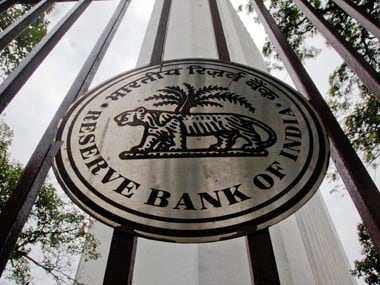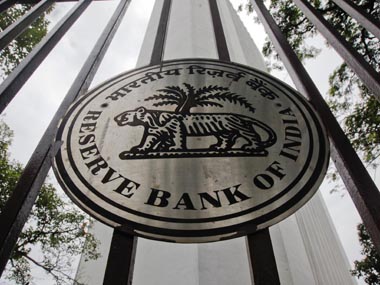More state-run banks, which have so far remained on the sidelines hesitating to join the lending rate cut spree, are likely to join the club in the days ahead. One can expect more lending rate cuts as early as this week. So far, mostly the bigger lenders such as State Bank of India (SBI), ICICI Bank and Axis have cut their base rates or minimum lending rates, after the 7 April monetary policy of the Reserve Bank of India (RBI). Transmission in bank lending rates is the first of the four conditions put forward by Rajan to cut rates further. The RBI has front-loaded its rate cuts by a cumulative 50 basis points (bps) in two rounds since January and is on a waiting mode after that. One bps is one hundredth of a percentage point. [caption id=“attachment_2076303” align=“alignleft” width=“380”]
 The RBI logo. Reuters[/caption] With banks reciprocating to the apex bank’s call, effectively the first condition set by Rajan has been met. Does this mean, yet another, off-the-policy, surprise rate cut before June? It is unlikely yet, if one goes by the logic of the remaining three factors outlined by Rajan in the policy document. These are: 1) Developments in sectoral prices, especially those of food, and the effects of recent weather disturbances and the likely strength of the monsoon. This is critical, since the RBI has made it clear that it will look through seasonal as well as base effects, and try to gauge the actual changes. 2) The RBI has also said it will look to a continuation and even acceleration of policy efforts to unclog the supply response so as to make available key inputs such as power and land. Further progress on re-purposing of public spending from poorly targeted subsidies towards public investment and on reducing the pipeline of stalled investment will also be helpful in containing supply constraints and creating room for monetary accommodation, the RBI has noted. 3) Finally, the Reserve Bank said it will watch for signs of normalisation of the US monetary policy, though it feels India is better buffered against likely volatility than in the past. The second and third factors, although theoretically critical and something emphasised by the central bank time and again as preconditions for easing monetary policy, are well beyond the control of the RBI. Fiscal policy improvements are often a matter of perception in relation to who speaks of it and the US Fed moves have become less of a concern. The NDA government has indeed taken the initial steps — to resolve the supply-side structural bottlenecks, reform land and power sectors, revive stalled projects — but each of these are work in progress and would take longer periods to show results, not sufficient enough time for the central bank to ponder over the progress in the medium term. As far as the normalisation of the US monetary policy is concerned, rate hikes are now a certainty there with only the timing remaining uncertain. But this is something the Indian central bank has termed as a less serious concern with the country better prepared to face volatility in capital flows. That takes the focus to the inflation, the critical factor for the RBI, which has positioned itself as an inflation-focused central bank. Inflation would be watch for immediate cues from inflation trends, to decide further on rate cuts. Until now, retail inflation has obliged to the gliding path originally envisaged by the Urjit Patel panel (8 percent by January 2015 and 6 percent a year later). The consumer price index-based (CPI) inflation for March eased to 5.17 percent from 5.37 percent in February, largely on account of a decline in food and vegetable prices. Food inflation too eased to 6.14 percent in March from 6.88 percent in the previous month. As Firtspost
noted early this week
, the easing trend in retail inflation is indeed good news for those hoping for more rates cuts from the RBI and, if seen together with the recent lending rate cuts by banks, keep the hopes of more rate cuts alive. But the risk factors are that March inflation doesn’t fully reflect the impact of the unseasonal rains on food prices. This may reflect in the coming months. Further, the benefit of base effect, which makes inflation seem lower, still worked in the favour of lower inflation during March and April. From May, this would begin to fade and there could be a spike. On a higher base in the corresponding period last year, the inflation will show a benign trend even though the quantum of rise in identical. Post April, the benefit of base effect will begin to fade, exposing the inflation numbers to its actual state of improvement. This is something the Rajan has highlighted when he said the central bank will look through the base effect. One can get a good sense of how the monsoon is going to pan out only by June-July. In short, with banks falling in line somewhat, the first hurdle for future rate cuts is cleared. The next and the critical factor will be the mood of rain gods and the movement of crude prices. If things go easy, the next rate cut can be expected in June-July.
The RBI logo. Reuters[/caption] With banks reciprocating to the apex bank’s call, effectively the first condition set by Rajan has been met. Does this mean, yet another, off-the-policy, surprise rate cut before June? It is unlikely yet, if one goes by the logic of the remaining three factors outlined by Rajan in the policy document. These are: 1) Developments in sectoral prices, especially those of food, and the effects of recent weather disturbances and the likely strength of the monsoon. This is critical, since the RBI has made it clear that it will look through seasonal as well as base effects, and try to gauge the actual changes. 2) The RBI has also said it will look to a continuation and even acceleration of policy efforts to unclog the supply response so as to make available key inputs such as power and land. Further progress on re-purposing of public spending from poorly targeted subsidies towards public investment and on reducing the pipeline of stalled investment will also be helpful in containing supply constraints and creating room for monetary accommodation, the RBI has noted. 3) Finally, the Reserve Bank said it will watch for signs of normalisation of the US monetary policy, though it feels India is better buffered against likely volatility than in the past. The second and third factors, although theoretically critical and something emphasised by the central bank time and again as preconditions for easing monetary policy, are well beyond the control of the RBI. Fiscal policy improvements are often a matter of perception in relation to who speaks of it and the US Fed moves have become less of a concern. The NDA government has indeed taken the initial steps — to resolve the supply-side structural bottlenecks, reform land and power sectors, revive stalled projects — but each of these are work in progress and would take longer periods to show results, not sufficient enough time for the central bank to ponder over the progress in the medium term. As far as the normalisation of the US monetary policy is concerned, rate hikes are now a certainty there with only the timing remaining uncertain. But this is something the Indian central bank has termed as a less serious concern with the country better prepared to face volatility in capital flows. That takes the focus to the inflation, the critical factor for the RBI, which has positioned itself as an inflation-focused central bank. Inflation would be watch for immediate cues from inflation trends, to decide further on rate cuts. Until now, retail inflation has obliged to the gliding path originally envisaged by the Urjit Patel panel (8 percent by January 2015 and 6 percent a year later). The consumer price index-based (CPI) inflation for March eased to 5.17 percent from 5.37 percent in February, largely on account of a decline in food and vegetable prices. Food inflation too eased to 6.14 percent in March from 6.88 percent in the previous month. As Firtspost
noted early this week
, the easing trend in retail inflation is indeed good news for those hoping for more rates cuts from the RBI and, if seen together with the recent lending rate cuts by banks, keep the hopes of more rate cuts alive. But the risk factors are that March inflation doesn’t fully reflect the impact of the unseasonal rains on food prices. This may reflect in the coming months. Further, the benefit of base effect, which makes inflation seem lower, still worked in the favour of lower inflation during March and April. From May, this would begin to fade and there could be a spike. On a higher base in the corresponding period last year, the inflation will show a benign trend even though the quantum of rise in identical. Post April, the benefit of base effect will begin to fade, exposing the inflation numbers to its actual state of improvement. This is something the Rajan has highlighted when he said the central bank will look through the base effect. One can get a good sense of how the monsoon is going to pan out only by June-July. In short, with banks falling in line somewhat, the first hurdle for future rate cuts is cleared. The next and the critical factor will be the mood of rain gods and the movement of crude prices. If things go easy, the next rate cut can be expected in June-July.
With more banks expected to follow ICICI and Axis on rate cuts, is it time for RBI to ease further?
FP Editors
• April 15, 2015, 11:49:25 IST
With banks falling in line somewhat, the first hurdle for future rate cuts is cleared; but the critical factor is the rains and crude prices
Advertisement
)
End of Article